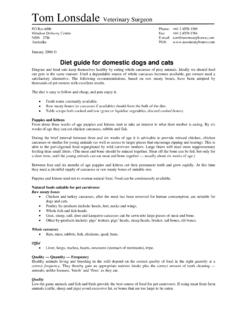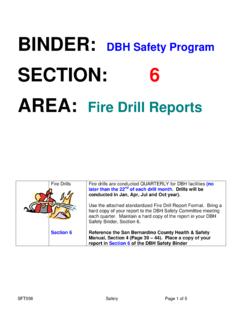Transcription of The History Of Winnemucca By J. P. Marden THE CENTRAL ...
1 The History Of WinnemuccaBy J. P. MardenTHE CENTRAL PACIFIC RAILROADT here have been many significant historical events that affected thehistory of the United States in which Winnemucca has been a participant,but none has been of greater significance that the joining of the east and westwith the iron rail. The building of the CENTRAL Pacific and the Union PacificRailroads in the 1860's truly united this country for the first time, and madewestward expansion a first proposal for a transcontinental railroad was made as early asthe 1830's, well before anyone knew what the western part of the continentcontained. The matter was brought before Congress for the first time asearly as the 1845-47 1853 the Pacific Railroad Surveys were authorized and by 1856were completed.
2 These surveys comprised thirteen volumes of informationand outline five routes that the railroad could utilize to cross the UnitedStates from coast to until the start of the Civil War the southern route was favoredmore so than the other four. With the advent of the War between the Statesthe southern route was out and there was a real need to bind the State ofCalifornia to the rest of the July 1st, 1862, President Abraham Lincoln signed the PacificRailroad Act, and the first transcontinental railroad was assured. This actalso chose the CENTRAL route through northern true father of the CENTRAL Pacific Railroad was Theodore DehoneJudah. His surveys of the CENTRAL route were meticulous and well done andhis testimony before Congress for the Pacific Railroad Act assured itspassage.
3 Judah lined up the financial support of four businessmen,Huntington, Hopkins, Crocker and Stanford the "Big Four" of the August 19, 1868, the tracklayers for the CPRR laid six miles and200 feet of track in a single day near Humboldt City Station. There was acompetition between the construction bosses of the CENTRAL Pacific andUnion Pacific, which was building from east to west, concerning the amountof track that could be laid in a single day. The Union Pacific soon beat thesix mile record. Shortly after the CENTRAL Pacific construction crew enteredwhat is now Utah they laid ten miles of track in a day, a record which hasnever been equaled or broken since then. At the time this record was set therail weighed between 56 and 64 pounds per the railroad company could sell a completed section of line tothe government it first had to be inspected by men from the U.
4 S. RailroadCommission. On September 5th, 1868, Inspectors Denver and Smith cameup the railroad as far as Humboldt City Station, or Humboldt House as it wasto be named, and accepted another twenty miles of finished railroad. Thismade 282 miles of the CENTRAL Pacific from Sacramento in running order. Atthis time the construction trains were at Raspberry Canyon, 24 miles furtherup the line, and the grade builders were past the railroad moved east it was connected to Idaho Territory andOregon by a stage line and fast freight service owned by Hill Beachey. Hisfreight and stage road from Humboldt House and Mill City is still apparentin many areas across the desert heading north.
5 Beachey was one of the mostfamous stage line owners in the CENTRAL Pacific rails reached Winnemucca on September 16th,1868, and was officially opened to Winnemucca on October 1st, 1868. The"Champion" was the first locomotive into town. There was no celebration atWinnemucca at the time of its arrival, and the work pushing the line to theeast continued. By November the railroad was completed through May 11th, 1869, the first through train of four cars passed throughWinnemucca at noon. The train carried Governor Safford, the RailroadCommissioners, and the President and Vice-President of the CENTRAL PacificRailroad Company. The Humboldt Register described the celebration inWinnemucca as follows: "We had a big time in Winnemucca celebratingthe completion of the railroad.
6 Firing guns, blowing whistles, ringing bells,'driving spikes', and drinking champagne, was the order of the day. Someof the boys are celebrating yet; others became so enthusiastic that they hadeast close by the slaughterhouse. This set of corrals was torn down in theearly 1970's. Thousands of cattle were shipped from Winnemucca to pointseast and west each year from the 1870's until the end of the 1920's. In theearly days it was said that a person could not eat a steak in San Franciscothat had not started life on northern Nevada Railroad Company formed the tax base for early HumboldtCounty. The people who lived in Humboldt County, and the rest of thestates served by the CENTRAL Pacific paid dearly for the few tax dollars CENTRAL Pacific figured their freight rates from the point of originthrough to San Francisco and then back to the destination of the example, a carload of coal oil shipped from New York to San Franciscoran up a freight bill of $500.
7 The same carload of coal oil shipped from NewYork to Winnemucca , 475 railroad miles less distant, cost $716. The buyerpaid $500 for the freight to go to San Francisco and $216 for it to come backto Winnemucca from San Francisco. The car of coal oil had been droppedoff in Winnemucca on its way west. The Railroad Company continued toprice freight this way until well after the turn of the 20th were bills introduced in the Nevada Legislature to make therailroad freight rates fare to all, but the CENTRAL Pacific controlled politics inNevada for a number of years, not only on the State level, but on the Countylevel as well. This influence would also continue well into the 20th CENTRAL Pacific Railroad changed the History of Winnemucca like no othersingle event ever would.
8 It brought the world to Winnemucca and Winnemucca to theworld. It insured that Winnemucca would grow and prosper for years to come. It alsobrought the County Seat to Winnemucca in COUNTY'S HISTORICAL LEGACY History OF Winnemucca ,HUMBOLDT COUNTY, CHINESE IN have been many different ethnic groups in Winnemucca andHumboldt County. Some of these groups stayed in Winnemucca and weresoon assimilated into the cultural mix that makes Winnemucca what it istoday. The one race of people that was never assimilated into the culturalmix in Winnemucca was the Chinese, and from the very earliest days oftheir arrival within this community, they remained separate. This could beone of the reasons that they are no longer part of the present cultural Chinese have been one of the most maligned, if not the mostmaligned, racial group in the United States.
9 They are the only racial groupthat was forbidden to immigrate to the United States by law. In 1880 California passed laws that put an end to Chinese labor use in that state. In1882 the United States followed suit with the Exclusion Act of 1882. Thisbit of legislation barred Chinese immigration for 10 years. This act wasrenewed over and over again and the exclusion policy remained in forceuntil World War II. At this time the law began to be modified until it wasfinally dropped, after 86 years in effect, in the 1968 overhaul of the early days many of the Chinese who had become United Statescitizens and returned to China to visit were refused entry when they tried 1893 a Chinese man by the name of Hi Loy, also known as "AceIn The Hole", went home to China for a visit with the family he had leftbehind.
10 When he returned in May, 1895, immigration officials would not lethim off the ship at San Francisco. The officials said that his reentry papershad been altered, and they refused to let him off the Loy wired Winnemucca and affidavits were produced stating thathe was a resident of Winnemucca and well known here to both the whitesand the Chinese. After several weeks had passed he was allowed todisembark and return to 1902 Sing Yuen, a Winnemucca merchant, returned to the UnitedStates after an extended visit to China. He was held in San Francisco forover two months while his paperwork was verified. A Treasury Departmentofficer came to Winnemucca and conducted interviews before Sing Yuenwas allowed to return to his home and problem of readmitting Chinese into the United States 1928 Yee Jam, the owner of the Hi Loy Jan store in Chinatown, wanted tobring his wife, Soo Soo Chee, to Winnemucca to enjoy his prosperity.









